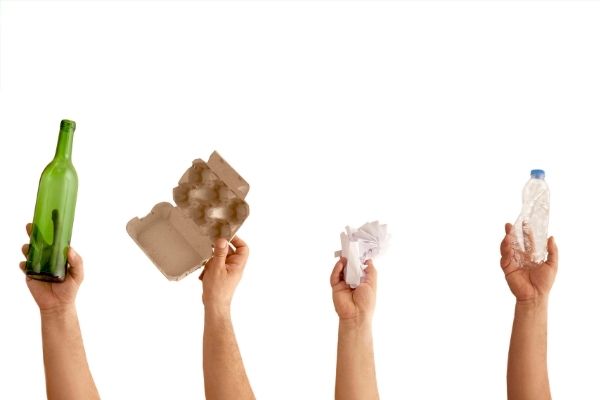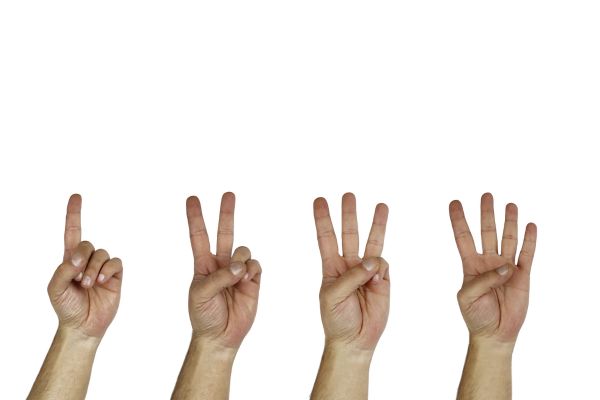Although recycling has a somewhat negative perception, this is not an entirely fair view. It is essential to recognize the work and effort that goes into resolving the complex process of collecting your recycling and finding new end uses for many materials. This work is continuously evolving and improving as the sustainability agenda gets more and more attention and we shift to a more circular system.
Below we take you through why recycling can seem so complicated and help you find your way to become a better recycler.
Material types and multi-layer materials
Most consumers don’t realize how many different materials there are out there.
Different materials continue to be invented for a multitude of different purposes. For example, a thin barrier layer of plastic will stop your coffee from leaking out of your paper coffee cup. A thin barrier could also be inserted onto your tray so that it can stack better when it is being transported from point a to point b. There are many decisions that go into making the objects in our lives, and unfortunately, more often than not, it makes things more difficult to recycle.
The majority of packaging that is not recyclable is made up of a specific combination of different materials. This is called a multi-layer material. Think Tetrapak or toothpaste tubes. While each material on its own might be recyclable, the combination of those materials together may not be.
Another example of multilayered materials is a chip packet. Chip packets are made from layers of polypropylene to protect from moisture, aluminum for strength, and polyethylene to enable the display of brands and nutrition. You can imagine how difficult it would be to recycle the thin packaging of chip packets when they contain so many different materials.
Fortunately, some countries have implemented soft plastic recycling programs to take chip packets. If you want to read more about soft plastic recycling and if your country has a program, click here.
Pouches containing refill liquid soaps or children’s juices are also made of different materials. This is because they all require properties in the packaging to protect and contain the specific product. Unfortunately, there are only a few schemes worldwide that are capable of separating these materials to recycle them efficiently and effectively. This means that these pouches will likely end up in landfills.
Nevertheless, it is important to look at the bigger picture of sustainability. It may seem unsustainable if we only look at an item’s recyclability, like the refill pouch. However, if you look at the entire life cycle of the thing and the overall benefits, it might appear differently. The benefit that refills offer to reduce overall packaging might outweigh the difficulty in recycling the material.
On a side note, some companies are beginning to design pouches using a single material to make them easier to recycle. This shows continuous improvement and a move towards the circular economy.
Capabilities based on location
Every region, city, or even country can only have a certain number of recycling facilities. This is due to economic, financial, and space factors. Each town or suburb can have quite different municipal collection systems based on the local facilities and which company wins the contracts. This can lead to different ways that materials are sorted, different types of materials being accepted, and different thresholds. This ultimately leads to confused consumers.
When it comes to the economics of recycling, it has to be economically viable for a recycler to process and sell that recycled material to a manufacturer. If there is no demand for that product, the recycler will not operate. The big question with recycling is: “What do they do with the material once you have recycled it?”
It can be expensive to transport recyclable items from a collection point to the plant if the plant is far away. It can sometimes cost so much in fuel to transport the recyclables to the plant that the money made selling the material is not worth it.
Recycling plants are also costly to set up and run, particularly when you cannot get the return for the materials. These factors create many barriers when it comes to establishing facilities.
Technology at recycling plant
Not only are there different types of materials accepted at most plants like paper, glass, plastic, but there are also subcategories within each of these types. If you take plastic, for example, there are many different sorts like plastic like Polyethylene terephthalate, High-density Polyethylene, or Polyvinyl chloride, to name a few.
Learn more about the types of plastics and whether they can be recycled or not in How to make sense of Plastic by Numbers.
To process all of these different categories and subcategories of materials, a recycling plant would need to have many different types of machinery. The capacity of a recycling plant to process so many different materials is limited by economics. Therefore, it’s often the case that one recycling plant will only process one material type based on their available machinery.
Not only does there need to be a plant near the location the material is discarded, but the plant also needs to have a machine capable of processing that specific material.
Terms, labels and logos
“Plastic,” “polymer identification code”, “on-pack recycling labels”, “recycled”, “plastic resin code,” and “recyclable” are all terms that some consumers might have seen or heard of somewhere. Instead of making things simpler, often, these labels create more confusion for consumers.
The fact that consumers are not educated about the meaning of these terms, logos, or labels can often lead to incorrect items being placed in the recycling bin. It can also lead consumers to think that particular things are recyclable when they are not.
Here are some definitions to help.
- Plastic actually describes any material that can be shaped and molded when you apply heat or pressure. It can be made from It’s not just one type of material but describes a vast range of materials with this common property. Learn more in our article what is plastic.
- The Polymer identification code or plastic resin code is a list of symbols placed on plastic to identify the type of polymer. This is the symbol of three chasing arrows with the little number inside it. People often think that this symbol means that an item is recyclable. However, it simply identifies the type of plastic that that item is made of and does not guarantee that is can be recycled. Learn more about the symbols in How to make sense of Plastic by Numbers.
- Recyclable means an item is able to be recycled. However, if it will actually get recycled depends on many other factors like you location and the facilities available in your area as discussed above. It also depends on whether there is a market for it.
- Recycled refers to an item that has been used, discarded and then recycled and processed through and made into a new product. Note just because something has been recycled doesn’t necessarily mean that it is recyclable.
Labels are supposed to provide clear instructions to consumers to help them know if packaging can be recycled based on the availability of recycling infrastructure in their area. This is greatly confused by the movement of products across states and countries where the availability of facilities varies significantly.
A piece of packaging might be clearly labeled with the recycling instruction for the location where it is designed, say California USA. However, if someone in New Zealand purchases the item over the internet, the label’s instructions may no longer make sense for that local area.
There are tools available that will help determine whether an item is recyclable. You can learn more in our article How to Recycle: Recycling Symbols and Meanings, where we describe the recently developed labeling for the USA, Canada, United Kingdom, Australia, and New Zealand.
Greenwashing
According to Investopedia, “Greenwashing is the process of conveying a false impression or providing misleading information about how a company’s products are more environmentally sound. Greenwashing is considered an unsubstantiated claim to deceive consumers into believing that a company’s products are environmentally friendly.”
However, it is important to distinguish between companies trying to do the right thing and companies who are intentionally being deceitful.
Many companies are trying to do the right thing. This could mean using recycled content, ensuring that the materials used are recyclable, or adhering to design for recycling guidelines. These companies label the products as recyclable based on the rules in their location. There is, as mentioned above, a possibility the product could end up in an area where there is no infrastructure to process it, and the labeling rules vary. It could be that a reseller is responsible for the product being sold in a different market, for example. It is good to keep an open mind and start by contacting a company to ask questions first.
On the other hand, some companies are trying to deceive customers to increase their sales. This is often in the form of words like “eco” or “green” on their packaging. These terms are often unsubstantiated.
What can you do to make it easier?
- Look up your local recycling rules with your local council.
- Break it down – there are only four basic types of materials that are generally accepted in curbside recycling (glass, plastics, paper and metal).
- Learn about the different polymer identification codes e.g. plastic numbers 1 to 7.
- Avoid mixed and multi-layer plastics.
- Don’t be afraid to ask (contact your local council or send Everyday Recycler a question).
- Stop wishcycling – this only leads to more work for the actual recycling company in sorting and sending to landfill.
- Refuse, reduce, reuse and repair before recycling.
- Understand which label claims are driven by science and which are “fluffy” e.g. “Eco-container”, “Green Cup”
- Buy recycled products to help make recycling more economical.
Conclusion
The complexity around recycling is multi-faceted and requires input and work from many stakeholders along the value chain. However, as consumers, we have the opportunity to help. We can educate ourselves (about what the labels and logos mean), we can also help educate our friends, family, and children. We can choose packaging that is designed to be recycled. We can make an effort to separate waste from recyclables at home.
We can acknowledge and commend recycling when it works. Think about the life of a PET plastic bottle, for example, being recycled into new items. We can accept that recycling is complex and may not work perfectly every time, but it has a higher chance of working when we help.
Sources
- NPR, 2014, The Weird, Underappreciated World Of Plastic Packaging
- Environmental Management, 2017, Life Cycle Assessment
- Margaret James, 2021, Greenwashing
- Petco, Designing for the Environment














